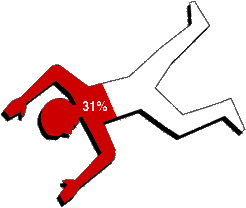Nearly 3 out of every 10 homicide victims in New York City in the early 1990s had evidence of cocaine in their bodies when they died. Overall, murder victims in the city are 10 to 50 times more likely than members of the general population to be cocaine users, depending on age, race, and gender, according to NIDA-funded research using data from the New York City medical examiner.
Dr. Kenneth Tardiff of Cornell University Medical College in New York City headed a team of researchers that studied the 4,298 homicides that occurred in New York City during 1990 and 1991. Cocaine was found in the bodies of 31 percent of the victims. About three-fourths of all the murders involved firearms.
 Cocaine was found in 31 percent of the 4,298 people murdered in New York City in 1990 and 1991.
Cocaine was found in 31 percent of the 4,298 people murdered in New York City in 1990 and 1991."Homicide victims may have provoked violence through irritability, paranoid thinking, or verbal or physical aggression, which are known to be pharmacologic effects of cocaine," the researchers hypothesized. Drug dealers' efforts to protect their sales territories from invading competitors also promote violence and homicide, they suggested.
Young African-American and Latino men were more likely to be victims of homicide than were members of all other demographic groups, the study found. Two-thirds of the victims were between the ages of 15 and 34, 86 percent were male, and 87 percent were African American or Latino. The rate of homicide was highest for African-American males ages 15 to 24, followed by African-American males ages 25 to 34. The next highest homicide rates were among young Latino men ages 25 to 34 and 15 to 24, respectively.
African-American women and Latino women had much lower rates of death by homicide than their male counterparts. However, their rates were slightly higher than those of white males, particularly in the 15- to 34-year-old age group. White females had the lowest homicide rates of any demographic group.
[Data is available in table format]
Among some of the young demographic groups of victims, cocaine use surprisingly was higher among females than among males. For example, 59 percent of white women and 72 percent of African-American women ages 25 to 34 had been using cocaine before they died compared with 38 percent of white men and 44 percent of African-American men in that age group. This "high proportion" of cocaine users among white and African-American female homicide victims is contrary to surveys showing that women in general are less likely to be drug users and shows that drug use is a key risk factor for homicide victimization among women, the study authors said. "It is possible that female users of cocaine are more likely than nonusers to be victims of violence from spouses, boyfriends, or, in the case of prostitutes, their clients," said the researchers.
The investigators attributed the high homicide rate they found among African Americans and Latinos to the increased availability and abuse of crack cocaine and the increased availability and lethal firepower of guns.
"There is no clear answer as to how we can decrease the heavy use of cocaine, particularly in our cities," the researchers said. "There is a major need for public treatment programs, but these will be very expensive, and treatment for cocaine addiction has no methadone analog yet. Prevention programs aimed at schools require adequate evaluation."
Source
- Tardiff, K.; Marzuk, P.M.; Leon, A.C.; Hirsch, C.S.; Stajic, M.; Portera, L.; and Hartwell, N. Homicide in New York City: Cocaine use and firearms. JAMA 272:43-46, 1994.
